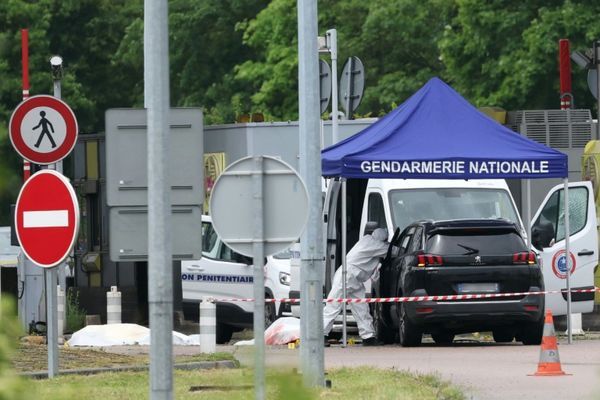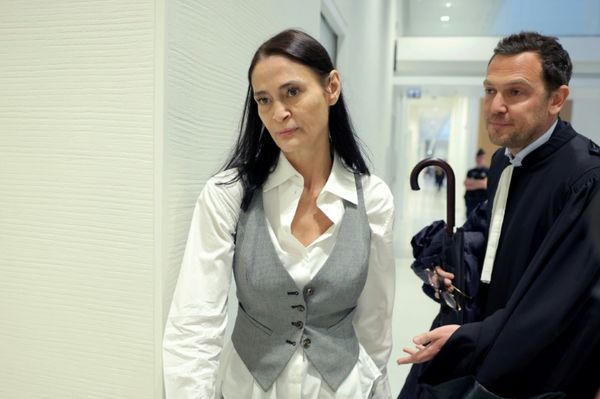
The smell of death hits you at the entrance to kibbutz Be’eri. Until Saturday morning Be’eri had a population of 1,200, the largest of the 12 villages that make up the Eshkol regional council that runs along the border with Gaza.
Now it is a place indelibly associated with horror and tragedy, as one of the centres of the massacre undertaken by the militant Islamist group Hamas in southern Israel beginning on Saturday morning.
Be’eri, once popular with Israelis as a weekend getaway with its art gallery and nearby mountain-biking trails, had by Tuesday been turned into a war zone, the bloated bodies of the Hamas terrorists who attacked this place still dotted around the kibbutz, and tanks and armoured cars at the entrance where Hamas smashed in.
Audible in the distance the sound of detonations can be heard coming from the direction of Gaza, outgoing artillery firing close by from the positions now occupied by the army.
Be’eri, founded two years before the state of Israel, was once a pleasant place to live with houses and apartments set apart among the trees, and grassy verges joined by little sandy roads. Now the homes are broken and violated.
In some places the doors of the surviving houses stand open as if the residents had simply left to go for a coffee at the kibbutz cafe, pictures of the families that lived here pinned with magnets to fridges.
In other places it is clear that the Hamas militants who stormed Be’eri set fire to buildings to drive out the occupants who were hiding there: to kill or capture. Mostly to kill.
Building after building has been destroyed, whether in the Hamas assault or in the fighting that followed, nearby trees splintered and walls reduced to concrete rubble from where Israeli tanks blasted the Hamas militants where they were hiding. Floors collapsed on floors. Roof beams were tangled and exposed like rib cages.

Many of the juxtapositions on Wednesday were jarring, describing how very ordinary lives were ripped utterly apart. In the kibbutz’s communal dining hall, where residents once gathered to take meals, there are still menus and posters for the kibbutz’s running club and a personal trainer.
It is also where the bodies of the dead, 108 in all, were brought and laid out to await collection by the emergency services.
Now it is the Hamas dead who are being removed by workers from Zaka, an emergency group, in white overalls and orange helmets and masks.
For the Israeli soldiers who now populate Be’eri, these are scenes promoting conflicting emotions. Moving through the kibbutz journalists shouted questions to a harried Israeli soldier who it transpires had fought there.

“When I arrived I saw soldiers fighting here just to get into the kibbutz,” he said. “We were going from apartment to apartment. We will have difficult questions to ask [in the future]. For now we have to look forwards: to the defence of the people and getting the survivors out.”
“I feel anger. I feel speechless and frustration,” said Richard Hecht an army spokesperson accompanying the international media. “You can still smell the bodies here. It’s overwhelming.”
Itai Veruv, an Israeli major general who led the fighting here, could only describe it in historic terms of the Jewish history of persecution. “What happened here was a pogrom,” he says.
It is a word that has been used repeatedly about Be’eri. “[It’s] what happened in Europe in the old days,” adds Veruv. “This was not a war. They wanted to kill and kidnap to Gaza. Women and children.”
The picture of what happened in Be’eri has been emerging piecemeal over several days. How in the space of the horrifying hours of the murderous rampage on Saturday, at least 100 people were slaughtered here, dragged from their homes and murdered or dragged off at gunpoint as hostages to Gaza.

That terrible experience was chronicled in text messages, and desperate calls to family calling for help, and in the gruesome videos shot by Hamas itself within the kibbutz.
In text messages during the attack with this Guardian reporter, one resident – who survived with their family – had pleaded for help in contacting the army as Hamas stormed neighbouring houses.
Describing sounds of nearby shooting, the resident said: “We need to get the army here. It’s not enough. Please get the army come to save us.”
Amit Man, a 25-year-old paramedic, was one of those who lived here. Her last contact was a text she sent to her sister Haviva from the kibbutz clinic, where she was treating the wounded members.
Then there was Yaffa Adar, an 85-year-old who had lived in Be’eri for most of her life. Among those missing, believed captured, there is video of Yaffa sitting surrounded by young men telling her to “smile” in Arabic.
For those residents of Be’eri still alive, things can never be the same.
“I feel like the state of Israel ceased to exist,” Amit Halevi, the 70-year-old chairman of Be’eri, told the Haaretz newspaper on Monday, echoing Veruv. “What is this, some pogrom in Lithuania?”
Uri Ben Tzvi, another survivor from Be’eri, compared his experience to one of the Holocaust’s most famous victims
“I was like Anne Frank,” said Ben Tzvi, 71, who hid with his wife in a narrow corridor in one of the kibbutz’s structures. “It was a pogrom. Like going back to the Kishinev pogrom,” he said referring to a 1903 series of massacres in what is now Moldova.







